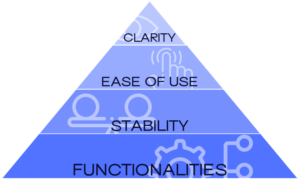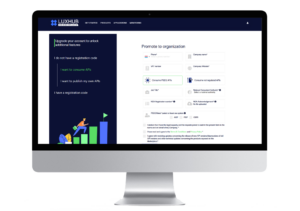DIGITAL SOLUTIONS
HUBTALK #1 – DX: applying UX rules within tech environments
Radu Popa, CTO at LUXHUB, discusses DX and its role in the current world where change is constant, and where customers do not hesitate to switch tools whenever they feel like it.
March 7, 2022

Nowadays, providing developers with intuitive tools and seamless experiences has become the key to boost usage of products and services, specifically in enabling innovative sectors, such as Open Finance, to reach their full potential. The concept of Developer Experience, or DX, has erupted recently: the primary user of the product is the developer, and he/she expects it to be smooth, seamless, and rich in terms of features, allowing him/her to save time, move intuitively, and therefore work efficiently. In other words, the developer expects to spend some quality time while using the company’s product(s).
Promoting innovative products to developers
In a world filled with developer portals and development platforms, not investing in DX might result in a significant drop in usage and might even endanger the company’s products. Users – and in this case developers – heavily influence the market as they decide which tools are fit, efficient and enjoyable to use. In fact, in the world of agile development and refactoring, rejecting a product based on usability and switching to new ones has become the norm.
“DX is at the intersection of UX and development principles. It is all about the rich experience you provide the developer with, when he/she is using a specific product, along with the related documentation, frameworks, open-source solutions, APIs, etc. Simply put: developers are to be treated as first-class citizens in the context of the product, in other words, as customers!” highlights the CTO of LUXHUB.
In B2B models, solutions delivered “as-a-service” – and that is the case for APIs – are not offered to end-users, but rather to third-party developers. They are integrating them within the products they develop, destined for end-users. “Furthermore, when talking about tech solutions as-a-service, there are many and inherent interactions with the developers of such solutions. Developers, either at the consumer or provider side, are customers,” adds Radu Popa.
As highlighted by the CTO, “Developers are explorers by nature, they are problem solvers. They don’t just code: they debug, maintain software, test, harden security, fix bugs and operate. Almost in equal measure”. The choice of available – and great – Software-as-a-Service offerings becomes ubiquitous. Yet, technical excellence is not enough: smooth development journey, comprehensive documentation and usage examples, support and analytics, etc., all contribute to DX.
The UX pillars and their DX counterparts
As most feelings and interactions users and developers face are similar, key DX pillars can easily be defined, based on the seven – or less, depending on the UX school of thoughts you favor – user experience pillars.
- Findability & clarity. How easy is it for developers to find their way the first time they use the product? How simple is it to find the functionality they are looking for? DX aims at supplying the right information for the developer to get his/her job done. This can notably be done by using coherent and intuitive visuals, as well as clear displays. What can also be added is messages giving full visibility of the consequences involved in an action, and the history of each action, to the developer.
- Usability & ease of use. It consists in going straight to the point with no unnecessary steps added to the process. This pillar is all about removing barriers and smoothing the journey: it enables developers to access what they need and when they need it, at all stages of their journey. Moreover, it is important to constantly ask for feedback to engage users/developers and obviously, to adapt and improve the product, and therefore the DX, based on users’ comments and needs.
- Credibility & stability. As in any experience, trust is key. Developers want to login to a trusted platform and use a proven product that will likely help tackle their main challenges. They want to use a tool that has a record of solving problems – and so do their C-levels. Of course, and especially in the finance world, security, reliability and performance remain crucial elements, and the developers active in this sector are deeply concerned with such prerogatives. The DX is also expected to meet the scaling and ever-changing needs of developers. If unstable and not flexible, the perception of value of the product will drop rapidly and significantly.
- Value & functionalities. Finally, what direct value does this product bring to me, the developer, the company I work for and eventually the end customers? Each product aims at becoming the first choice in the mind of the users/developers. In this specific case, the value lies in the reduction of the time-to-market, and in accelerating innovation, more generally.

“For instance, providing developers with a great onboarding experience is key as it gives them a robust and stable starting point. It can notably consist of demos, tutorials, and even knowledge trails. The typical flow for a business in using a new service is usually as follows: developer tries, business buys! Therefore, paying attention to developers’ needs makes actual business sense,” explains the CTO. In this respect, DX significantly helps save costs and resources and reduces time-to-market, enabling companies to focus on business needs.
Providing a powerful DX will result in the same outcomes as having a great UX: developers will not only keep on using the product but will also promote it. “They often share their insights, good practices and experiences with their peers, taking part in several communities. They might very well recommend using your product because it is providing them with a unique DX,” highlights Radu Popa.
The Marketplace and its revamped Developer Portal
Focusing on the customer – and the user – was one of Steve Jobs’ main principles. He once shared his thoughts on product creation process: “you have to start with customer experience and work towards technology, not the other way around.” In the context of DX, the quote of the former Apple CEO makes even more sense: tech is still important, but developers will pick a tool for the experience it provides them with!
LUXHUB, as an Open Finance pioneer and ecosystem banking advocate, is aware of the need to provide such rich experiences, to attract and retain developers, and enable Open Finance to reach its full potential.

The CTO adds: “providing developers with well-designed, self-service and easy-to-navigate tools will enable a faster development of the whole Open Finance ecosystem. By considering the developers’ needs and delivering the right experience, API platforms and hubs will become more attractive, API usage will grow, and eventually new services will be created. Developers – and the financial institutions or Fintechs they work for – will then be able to get the most out of Open Finance and the booming API economy”.
Currently working on an improved version of its marketplace which aims at achieving such great DX, the award-winning Fintech will soon announce the launch of its revisited Open Finance hub, built to answer business needs and ease challenges of developers, enabling re-shaping of the financial services industry, in a collaborative way.